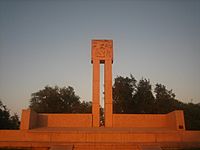Goliad Campaign facts for kids
Quick facts for kids Goliad Campaign |
|||||||
|---|---|---|---|---|---|---|---|
| Part of the Texas Revolution | |||||||
 Fort Defiance in Goliad, Texas |
|||||||
|
|||||||
| Belligerents | |||||||
| Texian Rebels; later the Republic of Texas | |||||||
| Commanders and leaders | |||||||
| José de Urrea | Frank Johnson James Grant † James Fannin † Amon B. King † William Ward † |
||||||
| Strength | |||||||
| 1,500 regulars, militia, and cavalry | 500 9 cannons |
||||||
| Casualties and losses | |||||||
| est. 20 killed, est. 350 injured or missing | 472 KIA, executed, or imprisoned 9 cannons captured 28 captured but escaped |
||||||
The Goliad Campaign was the 1836 Mexican offensive to retake the Texas Gulf Coast during the Texas Revolution. Mexican troops under the command of General José de Urrea defeated rebellious immigrants to the Mexican province of Texas, known as Texians, in a series of clashes in February and March.
When Mexico transitioned to a centralized government in 1835, supporters of federalism took up arms. Colonists in Texas, primarily immigrants from the United States, revolted in October 1835 and by the end of the year had expelled all Mexican troops from their province. With hostilities temporarily suspended, Frank W. Johnson and James Grant gathered volunteers for a planned invasion of the Mexican port town of Matamoros. James Fannin commanded troops stationed at Fort Defiance in Goliad.
Unbeknownst to the Texians, on February 18 Urrea led a large contingent of troops from Matamoros into Texas to neutralize the rebels gathered along the coast. His troops easily defeated Johnson's small force at the Battle of San Patricio on February 26. Several days later, informants revealed Grant's location, and on the morning of March 2, 150 Mexican troops ambushed Grant's men at the Battle of Agua Dulce. The Mexican army then turned northward, headed towards Goliad. On March 12, they encountered a group of Texian soldiers, under the command of William Ward at Refugio. The Texians repulsed Mexican attacks for several days. On March 15, as their ammunition ran short, Texians retreated from Refugio. Many were killed or captured.
Fannin ordered the bulk of his army to retreat from Goliad on March 19, in the hopes of joining the forces of General Sam Houston. That afternoon, Urrea's troops surrounded the Texians on an open prairie. The Battle of Coleto ended with a Texian surrender on March 20. Urrea marched the Texians back to Fort Defiance, where they were held under guard. One week later, under the orders of Mexican General Antonio López de Santa Anna, the Texians were marched outside the fort and shot.
The Goliad Massacre
The Texians were marched back to Goliad and held as prisoners at Fort Defiance, each believing that they were going to be set free in a matter of weeks. Knowing the prisoners' probable fate, General Urrea departed Goliad, leaving command to Colonel Jose Nicolas de la Portilla, and later writing to Santa Anna to ask for clemency for the Texians.
On March 26, 1836, 19:00, Portilla received orders from Santa Anna in triplicate to execute the prisoners. At around 8 a.m. on Palm Sunday, March 27, 1836, Colonel Portilla had the able bodied of 342 Texians marched out of Fort Defiance into three columns on the Bexar Road, San Patricio Road, and the Victoria Road.
Once the columns reached their selected location, the Mexican soldados formed into two ranks on one side of the captives. The Texians were then fired on at point-blank range only a few hundred yards from the fort. Colonel Fannin was the last to be executed.
News of the Goliad Massacre spread outrage, resentment, and fear among the population of the fledgling Republic of Texas and abroad.
Twenty-eight Texians managed to escape by feigning death and other means. Three known survivors escaped to Houston's army and participated in the Battle of San Jacinto. In some accounts of the Goliad Massacre, a Mexican woman, Francisca (Francita, Panchita or Pancheta) Alavez, sometimes referred to by other names (Alvarez or Alavesco), rescued about 20 Texian soldiers and became known as "The Angel of Goliad." Other people known to have rescued some prisoners were: Juan Holzinger (saved two German Texians captured among Capt. Amon B. King's men and at Victoria he saved twenty-six of Lt. Col. William Ward's troops by claiming to need them to transport cannons across the San Antonio River), Colonel Garay, Father Maloney (also referred as Molloy), Urrea's wife and an unnamed girl.

Written account
One survivor of the massacre, a young German named H. Von Ehrenberg, wrote an account of the murders on December 3, 1853. He said the Texan prisoners and American volunteers numbered about 400, while the Mexican captors totaled 700, in addition to cavalry and smaller groups of Mexican soldiers he saw gathered on the prairie.
Another written account can be found in Early Times in Texas (serial form, 1868–71; book, 1892) by John Crittenden Duval.

